What is killing my chickens. Guide to predators with identity table and images.
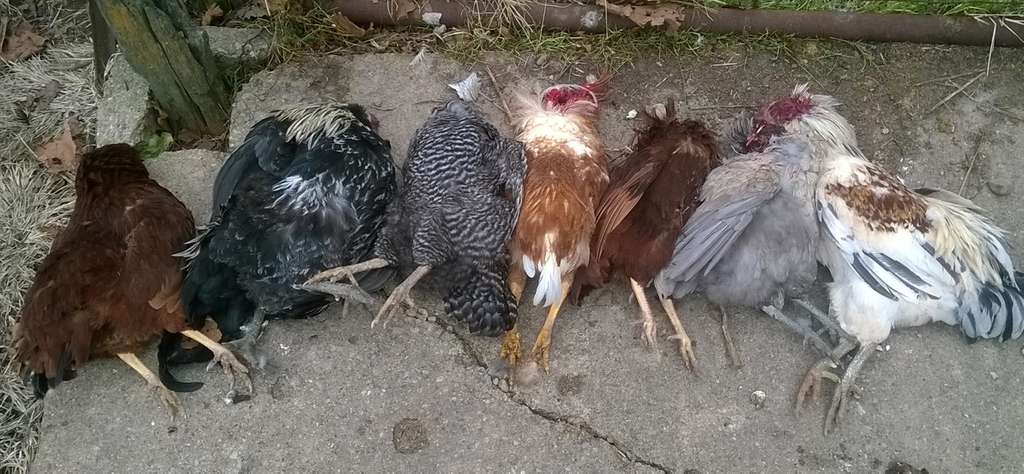
Predators kill in different ways and at varying times of the day.
Table of Contents
Being able to identify what is killing your chickens is vital to making sure it never happens again.
When I first started backyard chicken keeping I knew there was a possibility for predators but didn't know just how big the possibility really was. When I experienced my first loss of hens I was devastated. Not only because she came up missing, but because I had no clue what happened to her or what might have gotten her.
My recent survey of 2731 poultry keepers showed that 34.9% of them had suffered a loss to a predator in the last 12 months.
If you own a backyard flock, more than likely, you have experienced a predator or two, especially if you allow your poultry to free-range. However, chickens that free-range are not the only chickens susceptible to predator attacks. Even if you keep your flock is kept in an enclosure, they might not be safe.
Below: The most common sign after missing chickens is piles of feathers.
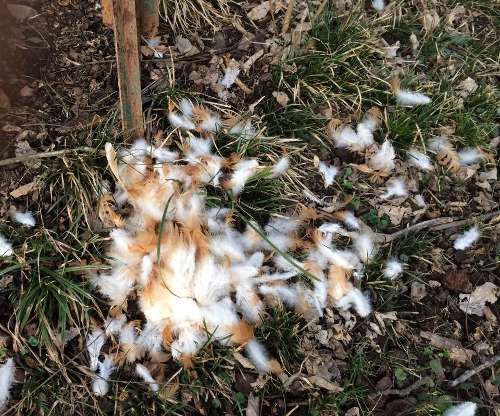
Working out what could be killing the chickens in your flock can help you protect against future attacks. Predators kill in different ways and at varying times of the day. The unwritten law is that predators always take the best or breeding birds and leave the surplus roosters.
There are generally three predator groups:
Nocturnal hunters - Bobcats, house cats, coyotes, foxes, weasels, raccoons, skunks, opossums, snakes, owls.
Low light hunters - Bears, Bobcats, house cats, coyotes, foxes, weasels, snakes, owls, hawks, crows.
Day time hunters - Bears, Bobcats, coyotes, foxes, weasels, snakes, hawks, crows.
Some predators may hunt any time and may be included in one or more groups and hungry animals or those with young to feed are likely to be more of a problem.
Often, the condition in which you find your flock is an indicator of which predator may have been involved.
Which animals kill and eat chickens?
In rough order of decreasing size the animals that kill and eat chickens are:
- Bears.
- Mountain lions.
- Coyote, wolf or dogs.
- Foxes.
- Bobcats.
- Raccoon.
- Opossums.
- Skunks.
- Domestic or feral cats.
- Weasels, Mink, Ferrets, Martens and stoats.
- Hawks, owls, crows and magpies.
- Snakes.
- Rats.
Depending on your geological location, and whether you live in a rural or urban setting, the types of predators may differ. Knowledge of predator behaviour provides background you can use as you try to identify and address predators of your flock.
A table to help you Identifying the predator:
The what killed my chicken identification table. Some animals normal routines are disrupted by humans.
| Predator | Time | Clues |
| Fox | Dawn/dusk | Single bird missing, scattered feathers outside. Multiple dead inside coop. |
| Coyote | Anytime | Many missing or eaten birds, feather puffs marking kill spots, single birds missing with no clues. |
| Bear | Anytime | Complete destruction |
| Bobcat | Night | Claw marks, feathers everywhere, Multiple birds killed and eaten. Some taken away or stashed. |
| Domestic cat | Anytime | Small chickens or chicks taken singly, single birds taken, wings, head and feet left. |
| Snake | Day | Single dead chicken, may have a wet head showing the snake tried to swallow it. Missing eggs. |
| Skunk | Night | Lingering skunk like odour, Neck chewed and ripped, organs eaten. Messy kill. Empty egg shells in and around nests. |
| Raccoon | Night | Empty shells, small chickens, chicks or true bantams taken, coarse fur left when squeezing through openings. Heads missing, necks and skin torn, entrails eaten. Carcasses dragged away. |
| Weasel | Night | Lingering skunk like odour, Empty egg shells. Many dead birds with powerful bites to the back of the neck. |
| Rat | Any | Missing or partly eaten chicks, toes eaten, rat runs, droppings and holes. |
| Mountain lion | Dawn/dusk | 1 to 5 birds missing with few feathers and no clues. |
| Dog | Any | Chickens badly bitten with deep puncture wounds and rarely eaten. Kills all chickens it can get hold of. Damaged fences and feathers everywhere. |
| Hawks | Day | Birds of prey take a single bird and tend to eat where they kill. Remains spread on back with most of the chicken eaten. Sparrowhawks may carry birds away. |
| Owl | Dusk till dawn | Deep puncture wounds on the back from talons. Feathers around a perch. |
| Opossums | Any | One or two chickens killed. Bites in breast or thigh, abdomen eaten, chickens eaten on site. |
| Humans | Any | Birds gone or dead. Human take or kill chickens for a variety of reasons. |
Remember that all these creatures are wild and pose a bite risk to humans so should you encounter any of them, handle the situation with great care and get help.
Still struggling, use a trail cam.
More detail on each of the types of predators:
Bears: Bears are large, strong, clever and single minded. Bears will eat the eggs, the chickens and the chicken feed. The signs that a bear has killed your chickens is big holes in the coop and puffs of feathers.
I remember watching the Mythbusters on TV testing bear myths and seeing a bear pull a door off a car to get to peanut butter. It just ripped the door off like I would open a card box. You will know if you have had a bear attack your coop as one whole side of it will probably be missing.
Below: The destruction of a bear attack.
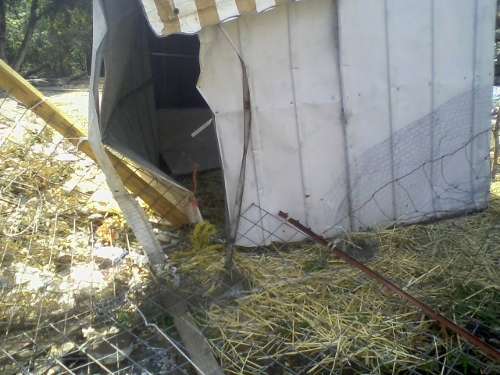
Speaking of bears being clever in that episode it actually opened the door using the handle on the first occasion. And it was not put of by any of the deterrents the tested except for the cayenne pepper.
The bear also crossed a two strand electric fence without even flinching.
Mountain lion, Cougar or Puma: Mountain lions are fast agile and good climbers. They are primarily nocturnal animals and are seldom seen in the middle of the day. They have a large range and can be found from coast to coast in North America.
Below: A mountain lion in a chicken run. Thankfully this one was not able to get into the coop.
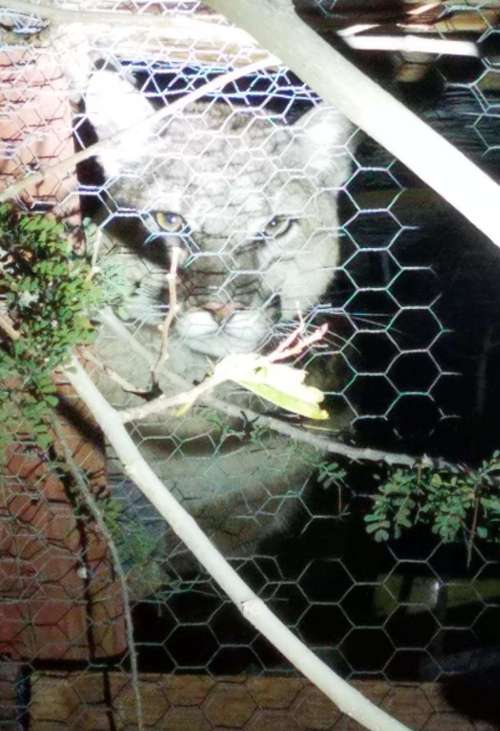
They are not common chicken predators but they will enter open coops or prise open weak ones if given the opportunity. The only protection against Mountain lions is weld mesh.
An adult mountain lion may be either a tawny, Gray, reddish or yellowish colour and the tip of their tail is black. A full grown animal may reach 4 to 5 feet in length, not counting the heavy tail, which is 2 to 3 feet long. Males are generally larger than females, averaging 130 to 150 pounds in weight. Females average 65 to 90 pounds. Mountain lions kill with a powerful bite and will probably kill all your chickens even if they only eat or take a few of them away.
Cougars are ambush hunters that use cover to stalk their prey but will take any unprotected livestock including chickens. Attacks are normally early in the day or later in the evening.
Coyote or Wolves and dogs: The dog family is found all over the world and have very similar killing styles. Coyote kill chickens with a bite to the neck but if they are chasing a flapping bird they will grab it anywhere they can. Chickens that manage to escape often have deep wounds on their backs from the canines.
Below: A chicken killed and eaten by a Coyote.

Wolves generally hunt in packs and Coyotes may sometimes hunt singly or in pairs, the same is true with domestic dogs, there may be one of more. It is rare that you will witness the attack itself and actually see any take your birds as they tend to avoid humans.
This is not the same for when domestic dogs kill chickens, they can get in amongst them at any time and are not bothered about who is watching. Domestic dogs are often just following instinct or in it for the fun of the chase rather than a need to eat and although they may start eating one or two birds they are mostly left. Wolves and Coyote will take and sometimes return to remove all they can.
Below: Birds that escape dog family attacks are likely to have deep puncture wounds or gashes on the body.
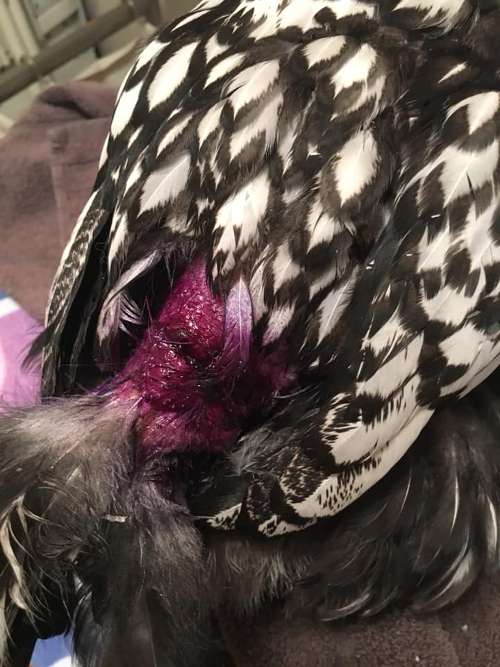
The evidence Coyote or Wolves and dogs leave will be remarkably similar as they will all kill everything they can reach with a powerful bite. You may only be left with puffs of feathers marking the kill sites.
Coyote or Wolves are not commonly found killing flocks of chickens but domestic dogs are much more of a threat being both closer to the birds and trusted more by people until it's too late. They gain entry by jumping over low fences, digging under barriers or brute force. Chicken wire only serves to keep chickens in and not predators out.
Foxes: Fox attacks can happen at any hour. I personally have them come in the depth of the night when the tore open a Silkie coop and got a trio of breeding birds and I have had them steal single chickens from a flock during the day. Luckily enough I have never had them get into a big chicken coop as they can kill everything.
Below: Foxes steal single birds or kill many in the coop. Birds are killed with a bite to the neck.
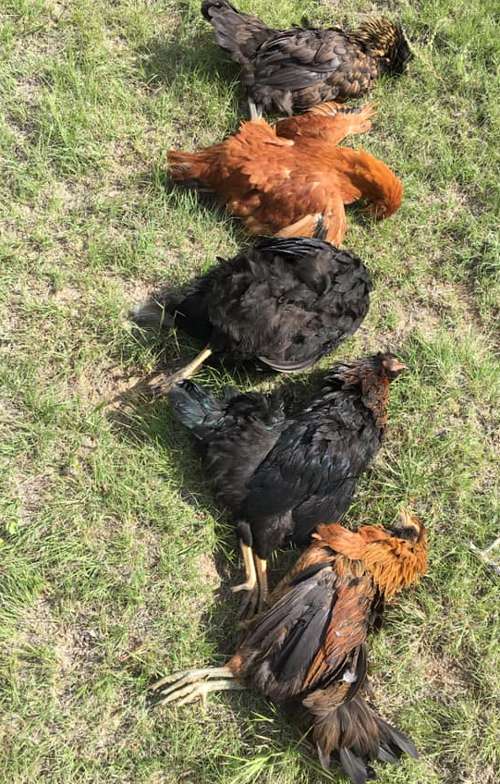
Foxes are quite small, the biggest I have ever dealt with was 22 Lb which is a monster by fox standards. They are sneaky, stealth and cunning ambush predators and will spend time learning what they can get away with.
Fox attacks can leave anything from a few feathers where a single bird was grabbed to a coop full of carcasses and just a couple of chickens missing.
Below: Foxes steal eggs as well.
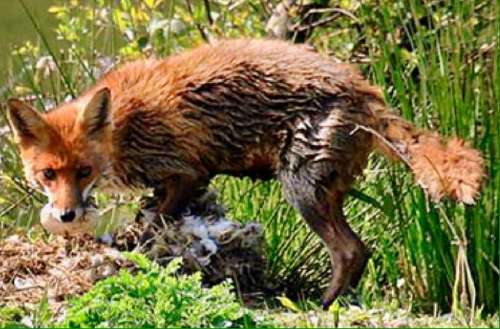
Although there is much variability in fox attacks they do have some hallmarks like single free range bird disappearing with little or no blood or evidence save the odd feather. If they succeed in getting into the coop any alive birds will have bald patches, broken wings or legs and deep puncture wounds.
Foxes have territories and check a lot of potential targets every time they go out hunting. They are relying on you to slip up and be a bit late locking the hen house door.
Bobcats: Bobcats are a North American wildcat that weights in between 7 and 9 kg that are found anywhere from North Mexico to Southern Canada. Bobcats are territorial and their prey includes anything from rodents to small deer.
Below: A Bobcat.
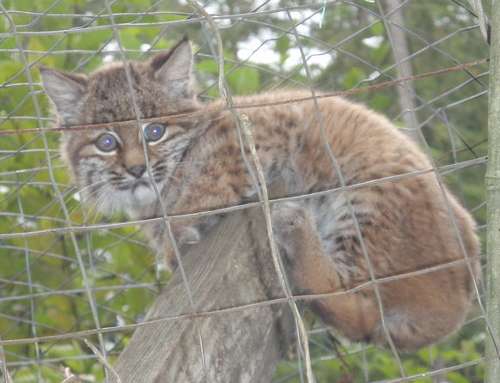
Prey depends on the season, location and habitat. The thing about backyard chicken flocks is they are not seasonal and are readily available all year round so even for an animal that might normally stay away from humans, hunger may drive them together.
A bobcat will generally just steal a single chicken and the only clue will be a few feathers in the grass.
Raccoon: Raccoon will eat chickens as well as eggs. It is rarely a clean kill and there is often a lot of mess and chewing involved. The real problem with raccoon is that there are so many of them and they are generally not bothered by human habitats.
Below: Raccoon kills tend to be messy and horrific to deal with.

The hall mark of a raccoon attack is multiple birds killed with the head and some of the neck and breast meat eaten. They rarely steal a single bird during the day (this is when they are more likely to take eggs) as chickens can get away from them when it's light. Instead they prefer to gain entry after dark and killing up to a dozen birds.
It is normally only one that is eaten and there is normally no effort to hide the food or move it away.
Raccoon are dexterous and strong and have a surprising reach. They can open latches a sliding bolts and squeeze through gaps as well as dig. Their skills make them a formidable opponent of the backyard chicken keeper.
Opossums: Opossums are more opportunistic and will settle for eggs or chicks before taking on a fully grown chicken. They do kill large birds though in a similar manner to raccoon but they are not as adept at climbing or opening latches. They can climb.
Below: 2 Opossums caught killing chickens. They often kill 2 or 3 chickens and drag one away for later.

Opossums attack the head and neck and their smaller size means it can leave a horrific mess as the kill is neither swift nor clean. They will leave and opened carcass with a missing head and rarely kill more than two birds. The second is normally missing as they will take it with them.
Below: Opossums attacks can leave devastating injuries.

They have been likened to vampires and seem to have a taste for blood.
Skunks: Skunks are much more likely to be egg thieves and the chances of one taking on a chickens out of choice is unlikely. They do however have sharp teeth and claws and will happily take young birds and chicks.
Below: A skunk. More likely to be after eggs but will take chickens.

The signs of a skunk attack are having the neck and / or throat ripped out of a single bird. The skunk will then proceed to eat a few ounces and then leave. They are nocturnal and can dig quite well so if your chickens are securely locked away at night behind stout fences you are unlikely to ever have a problem.
Domestic or feral cats: Domestic and feral cats are rarely a problem to full grown chickens but can and will take young birds or true bantams.
Below: This cat has killed a young cockerel.
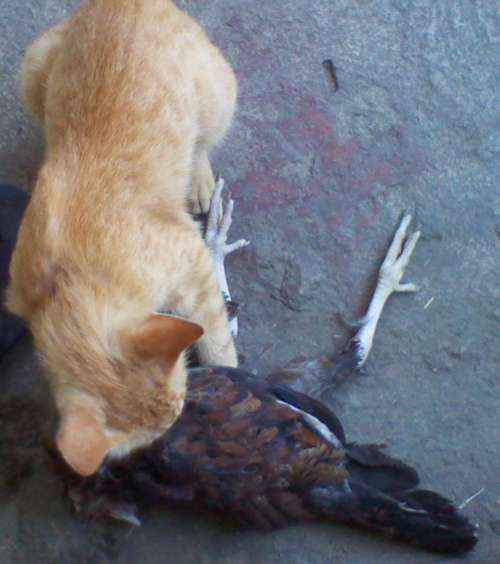
Some large feral cats may take on full grown hens but the result is not a forgone conclusion.
The other reason ordinary cats are not much of an issue is they tend to hunt at night after the hens are roosting safely in a coop.
Weasels, Mink, Ferrets, Martens and Stoats: The weasel family or mustelids is large and diverse group of animals but shares many of the same characteristics. The aftermath of a weasel attack will leave a distinctive and lingering smell not unlike that of a skunk.
Below: The weasel family tends to kill everything it can.
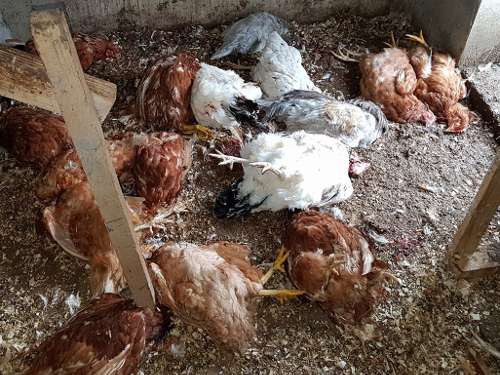
They kill multiple birds and may dispose of the entire flock if they have the time. They kill with a powerful bite to the back of the neck and tend to eat the heads or rip open the vent of the chicken.
Killed birds are piled up in corners or tucked away, sometimes in nesting boxes and bantams or chicks are often taken away. Food is stashed for them to return to later.
The weasel family is strong for its size as well as being fierce and tenacious and you should never tackle one without help or a weapon, it is much safer to trap them. The weasel family is long and thin and designed for squeezing into narrow tunnels so getting through a rats hole into your coop is nothing to them.
Birds of prey, Hawks, Owls, Crows and Magpies: Owls are very unlikely to be a problem as they are normally dusk to dawn hunters. A full grown large fowl chicken is unlikely to be taken by an owl but there are always exceptions. Owls feeding young will have to hunt more in daylight hours and this will bring them into contact with chickens. Bantams and chicks are the likely prey.
Below: Hawks and other birds of prey will take single birds. Most birds of prey are protected by law and well armed with beak and talons. Use extreme care if you have one inside your coop.
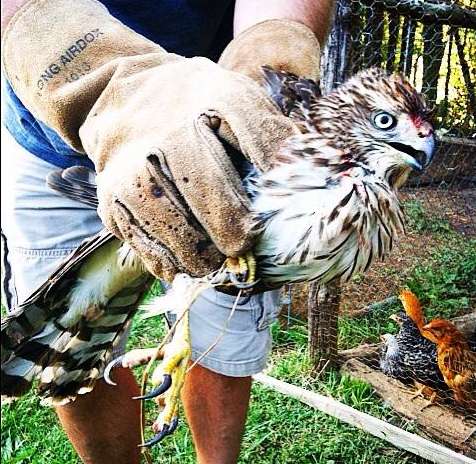
The corvite family is really only a threat to chicks and young birds. After around 8 weeks of age they can defend themselves against rooks and crows.
Hawks and kite will generally kill a single bird and eat it where they kill. Normally all you will find is a flat skeleton surrounded by feathers.
Snakes: Some snakes will feed exclusively on the eggs like the rat snake and some will take birds and eat them, like the pythons. Very often the only sign is a single missing bird.
Below: Rat snake eating an egg in a nest.
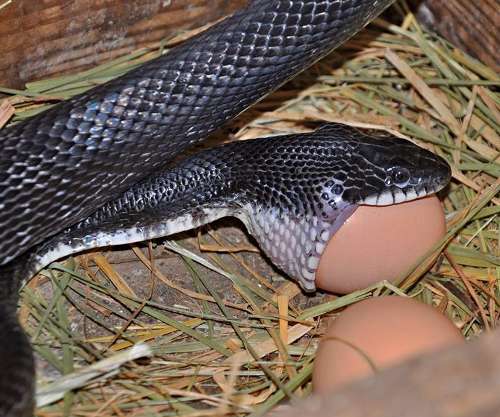
The hallmarks of a snake attacking chickens is a single dead bird, either missing and eaten or poisoned by the venom. It is quite common for US chicken keepers to find a snake helping itself to an egg in the nest.
Interestingly snakes do not seem to set off the flight response other predators do with chickens. This is sometimes why they get bitten, they go and see what the slithery thing is passing thorough the coop.
Below: Snake eating a chicken.
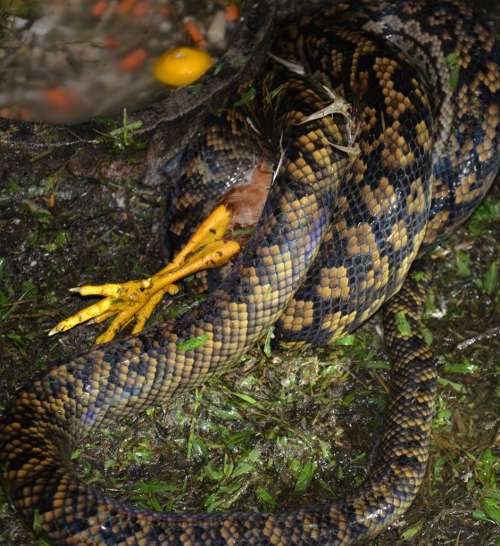
Very small snakes are probably more at risk from the chicken than the other way around, I am always surprised by what chickens can stuff down their gullets. Most snakes are not be a danger to your adult poultry, but predation by snakes does happen.
You might find a chicken with a wet head, indicating that the snake tried to swallow it and then gave up because she did not fit. Snakes ingest their prey whole and those that do manage to swallow an entire chicken would not be able to get out of the coop unless there is already a chicken sized hole.
Rats: Rats are unique in this list, they will kill a full grown chickens as well as any chick or take eggs. they will also eat your chicken feed.
The signs of rats are the runs and holes in the coop, missing chicks or nibbled toes. I have found a half eaten chick still under a broody hen. Rats are clever and tenacious and require constant control.
Humans: I was in two minds about whether or not to include humans as being two legged predators. The sad fact is there are people who will take your birds from you for a few reasons.
Below: This chicken has been run over.
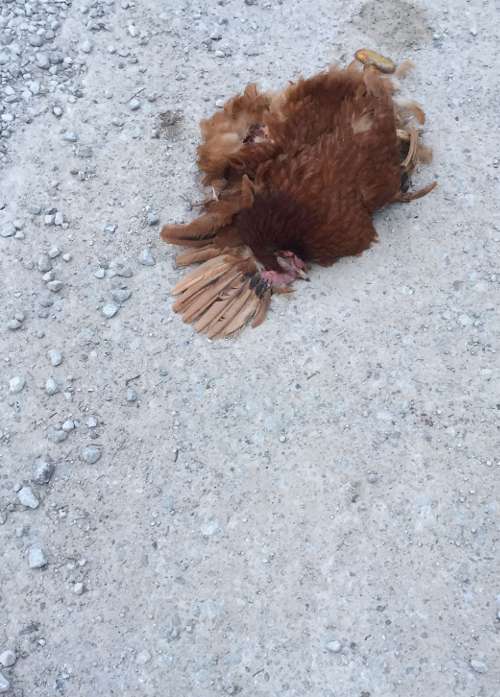
The may be annoyed at you keeping them, just want to eat them or will sell them on for money.
Tips for keeping your chickens safe from predators:
- Avoid attracting vermin into the chicken keeping space. This often brings snakes and larger predators in afterwards.
- Have good raccoon proof locks on door and entrances.
- Motion activated light or randomly twinkling Christmas style lights might provide a deterrent to some predators.
- Electric fences or a hot wire around the top and bottom of the run.
- Automatic pop hole door controlled by light levels to lock birds in.
- Consider a covering or roof on the run to stop aerial attacks.
- Pet dogs will help keep smaller predators like Opossums and skunks away.
- A small radio to play light classical music around the coop may help.
- Use decent fencing materials buried to at least a foot deep.
- Guinea fowl make a ruckus and may help depending on the predator.
- Alpaca's have been known to kill foxes.
- Fix holes in your coop and cover them with wire wool, it is the only thing that works on rats.
- Keep trees for cover from the air but trim bushes along the margins that could hide ambush predators.
- Vertical pole fences are difficult to climb.
Other ways to identify predators:
A predator attack most always happens when you least expect it. No matter how much you try to stay alert and protect your livestock, a predator will somehow outsmart you.
The reason is, they are creatures of opportunity. And trust me, they can wait you out longer than you can wait them out.
Sad but true, when you own livestock of any sort, you must be willing to accept loss. Trust me, we've experienced enough of our own.
- If adult birds have gone missing and you are sure they are not nesting away from the coop and no other signs of disturbance exist, the predator was probably a dog, a coyote, a fox, a bobcat, a hawk, or an owl. These predators typically are able to kill, pick up, and carry off an adult chicken and other poultry. In some cases puff of feathers may be in evidence on the ground where the attack happened, but not always.
- If chicks are missing but no other signs of disturbance exist, the culprit may be a snake, a rat, a raccoon, or a house cat. Such predators sometimes leave some feathers and wings scattered away from the site because they are not able to eat these parts.
- If birds are dead but not eaten and have parts still intact, a weasel may have attacked the flock. Members of the weasel family, including ferrets and mink will kill and stash the chickens or just get caught up in heat of the moment and kill everything they can. Often, the chickens’ bodies are bloodied where they have been ripped open and you might notice that internal organs have been eaten.
- If birds are dead and not eaten but are missing their heads, the predator may be a raccoon, owl or possibly a opossum. Raccoons sometimes pull a bird’s head through the wires of an enclosure and then can eat only the head, leaving the majority of the body behind. Also, raccoons may work together, with one scaring the chickens to the far end of a pen and the other picking off the birds’ heads.
- If birds are only wounded, not dead, various predators may be to blame. If birds show signs of bites all over, a dog may have attacked the flock. Domestic dogs may be too small or do not have sharp enough teeth to kill animals cleanly.
- If the wounds are on the breasts or legs of young birds, an opossum may be the problem.
- Bites on the hocks of young birds often indicate that rats have preyed on the flock.
- If birds have bites and show signs that their intestines have been removed through their cloacae, the attacker may be a member of the weasel family, or cannibalism may be occurring in the flock.
- If eggs are missing, one of several predators may be to blame including foxes, skunks, snakes, rats, opossums, raccoons, blue jays, and crows.
As long as you own poultry your flock will always be a living target. So, obviously, the best solution for protecting your flock is preventing predators from getting to it.
